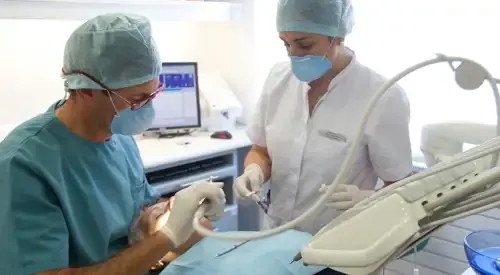Bruxism
"In more severe cases of tooth wear or temporomandibular joint problems, discharge arthroscopy may be necessary".
DR. JUAN JOSÉ GAITE
CODIRECTOR. DENTAL UNIT
What is bruxism?
Bruxism is a nocturnal, unconscious, intense and rhythmic movement of the masticatory muscles.
Bruxism is very frequent in children (juvenile bruxism), without being considered pathological at that age, but a natural form of dentition development and a stimulus of muscular and bone development of the face bones, tending to disappear when reaching the second decade of life.
However, in adulthood, the bruxist habit can cause multiple problems depending on the frequency and intensity.

What are the symptoms of bruxism?
Bruxism can lead to tooth enamel wear, jaw or dental pain, temporomandibular joint disorders and headache.
If it is very intense, it can interrupt sleep, not achieving the restorative function of the same.
The most common symptoms are:
- "Grinding" of the teeth during the night.
- Wear of the dental enamel.
- Jaw or dental pain.
- Alterations of the temporomandibular joint.
- Headaches.
Do you have any of these symptoms?
It may present bruxism
What are the causes of bruxism?
Stress plays a very important role in bruxism. People with this habit, generally support high levels of stress and the intensity of bruxism depends on the level of stress in each moment.
Occlusal interferences, that is to say, alterations in the teeth that cause them to mesh poorly, force the body to try to wear away these interferences in order to achieve an improvement in occlusion (the way the teeth fit together).
Generally, wear does not solve the problem, but rather aggravates it, since as the teeth wear down, they fit together more and more poorly.
What is the prognosis?
A characteristic wear occurs on the teeth. At the level of the gums, it weakens them so that, in the long run, inflammation and mobility of the teeth will appear.
But the most damaging effect is on the muscles and the temporomandibular joint in the form of headaches, earaches, neck pain, pain when opening the mouth, noises when opening the mouth and with time difficulty in chewing, or even speaking.
How is bruxism diagnosed?

On many occasions, the patient may be unaware that he suffers from bruxism and usually discovers it during a routine dental check-up or because someone in his environment picks up the noise he makes when he grinds his teeth.
Since bruxism is unconscious and nocturnal, the only way to diagnose it is during sleep, either directly by visualizing the habit, or by measuring the activity of the chewing muscles during the night by means of an electromyography.
Since bruxism causes effects in different parts of the masticatory system, the diagnosis is made indirectly by observing the wear and tear of the teeth and the tension of the muscles.
An early diagnosis of bruxism can prevent, among other complications, premature wear of teeth.
How is bruxism treated?
Early treatment prevents premature wear of teeth
The treatment aims to minimize the harmful effects by achieving a stable occlusion and the use of discharge splints.
If there is already a lot of wear on the teeth, it is very important to repair it so that the teeth have the proper shape, otherwise it will be very difficult to achieve the proper occlusion.
When it is not possible to improve the occlusion, the placement of a discharge splint is recommended as a preventive measure.
The splints are usually placed during sleep. In addition to preventing wear, they solve the other symptoms derived from bruxism: headaches, earaches, neck pain, etc.
In very severe cases, medications such as triptizol can be used, which alter the phases of sleep, which seems to avoid the bruxing habit as a side effect.
Where do we treat it?
IN NAVARRE
The Dental Unit
at the Clínica Universidad de Navarra
The Clínica Universidad de Navarra has extensive experience in rehabilitation with dental implants, with highly satisfactory results for patients and professionals.
In order to achieve better care for complex patients or those with risk factors which may influence safety during the intervention, we work together with the different medical services of the Clinica: Cardiology, Endocrinology, Allergology, Pediatrics, Speech Therapy, etc.
Diseases we treat
- Dental abscess
- Cavities
- Periodontal disease
- Loss of teeth
- Dental pain
- Malocclusions
Treatments we perform
- Dental Implants
- Orthodontics
- Dental surgery
- Endodontics
- Fixed dental prosthesis on teeth and implants
- Removable prosthesis
- Cleaning and teaching of oral hygiene
- Pediatric dentistry

Why at the Clinica?
- Safety and comfort in our treatments while being in a hospital.
- Equipped with the best technology on the market.
- Multidisciplinary work with the rest of the specialists of the Clínica.




